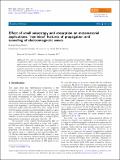Показать сокращенную информацию
Effect of small anisotropy and absorption on metamaterial applications: “non-ideal” features of propagation and tunneling of electromagnetic waves
| dc.contributor.author | Starodubtsev, E. | |
| dc.coverage.spatial | France | ru_RU |
| dc.date.accessioned | 2024-04-23T07:34:47Z | |
| dc.date.available | 2024-04-23T07:34:47Z | |
| dc.date.issued | 2018 | |
| dc.identifier.citation | Starodubtsev, E. Effect of small anisotropy and absorption on metamaterial applications: "non-ideal" features of propagation and tunneling of electromagnetic waves / E. Starodubtsev // EPJ Applied Metamaterials. – 2018. – Vol. 5. – P. 1–13. | ru_RU |
| dc.identifier.uri | https://elib.gstu.by/handle/220612/33696 | |
| dc.description.abstract | For cases of isotropic, uniaxial, and biaxial electromagnetic metamaterials (MM), a comparative analysis of the effect of small deviations of local material parameters from "ideal" values on the realization of MM applications ("zero" media, the Veselago-Pendry superlens) has been carried out. On the basis of the detailed investigation of the solutions of dispersion equations, it is established that even a very small dielectric and (or) magnetic anisotropy of a general form is the universal "non-ideal" factor determining (to a much greater extent than small losses) the operability of those MM applications where the wave misphasing in the effective medium is undesirable. The characteristics of wave attenuation in the absorbing isotropic and weakly anisotropic MM are mainly comparable for the applications. Limitations of the traditional approaches using the second-order curves (or surfaces) for analytic modeling of the absorbing MM dispersion equations are shown. | ru_RU |
| dc.language.iso | en | ru_RU |
| dc.publisher | EDP Sciences | |
| dc.title | Effect of small anisotropy and absorption on metamaterial applications: “non-ideal” features of propagation and tunneling of electromagnetic waves | ru_RU |
| dc.type | Article | ru_RU |
| local.identifier.doi | 10.1051/epjam/2017014 |
